Back to The Discus.com Learning Center
Back to The Discus.com Learning Center
Distinguished members of the family Cichlidae and the genus Symphysodon, discus are considered by many hobbyists to be the ultimate in freshwater fishes. Called the “King of the Aquarium,” there is a mystique about discus that transcends their snazzy good looks and fascinating behavior. Many experienced fishkeepers think of discus and groan that they are impossible to keep, even more impossible to breed, make impossible demands, and ultimately are simply not worth the effort. Even though these hobbyists should know better, they blame the fish even to the point of resenting that discus are cichlids. Because of these prejudices, the potential discus keeper must first develop a thick skin and a snappy repartee. When you think of keeping discus, there will be many that will mock your enthusiasm… and question your sanity. They will chide you for your foolishness and accuse you of closet masochistic tendencies. They will presume the right to ask positively intrusive questions about your household finances, assuming that you have taken a second mortgage or sold your firstborn into slavery to finance the operation. When all else fails, and you are keeping discus and keeping them well, they will tease you that you have the perfect eating fish, an adult discus being just the right size and shape for the frying pan. Unfortunately, there are photos… historic photos… of bare breasted Amazon beauties with painted faces happily munching on blue discus. The color looks too good for the fish to have been cooked, so I must assume that the photos were posed and the photographer was working purely on shock value. Of course, I may be way off beam here, and the discus may be purely incidental… the photographer may just have been taking a photo of a bare breasted Amazon beauty as she happened to bring a blue discus to her lips. For your own peace of mind, don’t dwell on it.
Pay your tormentors no mind. These poor souls are jealous, consumed with envy, and inhibited by their own self-imposed limitations. You can do it. You can keep discus and you can breed them and it doesn’t take a king’s ransom to make this happen. Just a little common sense, attention to the basic needs of the fish, and you’ll be fine.
I won’t bore you with the details of my own early forays into discus keeping. I am stubbom and don’t always read instructions, assuming that I know what I’m doing and things will always turn out well in the end. But as I get older and the fine print ever more difficult to read, I have discovered that it is right and good to read as much as possible before I do anything, even when I think I know what I’m doing. It’s a paradox. If nothing else, reading up on a subject is an affirmation that we are indeed no longer novices, and there is hope that we can succeed given a bit of luck and a modicum of common sense. There is little difference between keeping discus and any other South American fish. If you have managed to keep an oscar, corys, or angelfish and apply a few basic principles, you should have little trouble keeping discus.
So much for the pep talk; now down to the nitty gritty.
Discus are true tropical fishes, hailing from the warmest river waters of equatorial South America. This means they require warm water. Some attempt to keep discus at 26°C (~78° F), perhaps as a concession to the plants and other fishes they may already have, and may have moderate luck in the short term. But low water temperature is stressful and the discus will break down over time, being especially receptive to intestinal flagellates, or Hexamita. The best temperature range for discus is 28°-30° C (~82-86° F), with temperatures as high as 32° (~90° F) being useful when fish are first introduced to a new environment. The higher temperatures are a tonic to them, and it is not out of order to keep them at 31-32° C (~88°-90° F) until they settle in. These high temperatures are also used when treating the fish for some conditions, such as Hexamita, by speeding metabolism and the function of medications. I use 150-watt submersible heaters for 110 liters (~30-gal) tanks. For 75 liters (~20-gal) tanks and smaller, I use 100-watt heaters.
Before you bring your new discus home, you must have the tank ready and the filter cultured. It’s a fool’s game to think that you can buy the fish and then set up the tank. It’s been done, but more often with poor results than success. It doesn’t really matter too much what kind of filter you use as long as there isn’t tremendous water flow. Most long-time discus keepers are quite satisfied with large sponge filters in tanks up to 110 liters (~30-gal) where the fish are lightly stocked. For larger tanks or heavier stocking densities, consider more intense filtration. If you are just starting out with small fish, you’ll be fine with a cultured sponge filter. It you just can’t wait for the filter to culture naturally, consider using one of the bacterial starter cultures. They work very well and reduce the possibility of introducing diseases with cultured gravel or old sponge filters. For six young discus (5-7.5 cm / 2-3″ in size), a 75 liters (~20-gal) or 110 liters (~30-gal) tank is ideal, with the latter being more suitable to serve over the long-term. While it is usually recommended that we start with six fish, I would consider three the minimum. Two discus are likely to fight and the third seems to offset aggressive tendencies. While aggression in small discus is rarely fatal, the fighting is neither pleasant to watch nor likely to benefit the victim. It is ultimately better to start off with the six and remove the weaker fish as they are identified. This practice will often result in there being only two fish left in the tank, but likely those two will be a pair of very precocious discus that will start to lay eggs at an early age.
Many times we are told that bare-bottom tanks are the best way to keep discus. I’ve kept discus in many kinds of tanks, from fully planted show tanks with other compatible species to the bare-bottom “sterile” tanks often recommended by other breeders. For my own fish, whether they are breeders or juveniles, I use a thin layer of very fine gravel on the bottom. This makes siphoning easier as the substrate helps to trap wastes. The fish also appreciate the gravel and can be seen blowing into the substrate as they hunt for food. Discus will do fine in bare-bottom tanks, but I like the touch of gravel. If you do elect to use bare-bottom tanks, be sure to paint or otherwise cover the outside of the bottom glass, as the fish do not do well if they can see through the bottom; it disorients them, and they remain skittish and shy.
In addition to the fine layer of gravel, I like to use driftwood (preferably covered with Java fern), floating plants like water sprite and water wisteria (both are quite comfortable in discus water), and clay flowerpots filled with gravel and other suitable plants. A fluorescent strip light with one warm and one cool white bulb will provide adequate light for the plants. It is true that discus will bolt if the lights are turned on suddenly from total darkness, but discus should not be light intolerant otherwise. In this regard, floating plants diffuse the light nicely before it reaches discus level.
For a quarantine or hospital tank though, I do not use gravel or any other accoutrements. If this is the first time you are keeping discus, the initial tank is essentially a quarantine tank. In this case, the tank should be bare except for filter, heater, and light. The reason for this spartan arrangement is that you will want to be able to observe your discus very closely and even though they might want to hide, it’s better that you are able to see them clearly. If you do have to medicate, it’s a disadvantage to have plants, gravel, or other tank furnishings. You can always add the amenities after you are sure your new fish are healthy. This quarantine period should be no less than 30 days. If you are adding new fish to an established discus aquarium, be sure to keep the new fish separate ñ a 38 liters (~10-gal) tank will usually do ñ until you have had ample opportunity to evaluate their health.
Do you know your tap water? I would venture that most tap water is safe for discus with very little modification. If we can drink it, it shouldn’t kill your discus. (I write this with my fingers crossed though, because there are places in this world where maybe it’s wiser to avoid drinking the tap water!) You will have to remove chlorine and chloramine, and perhaps adjust the pH, but until your fish are of breeding age and condition, the hardness is not critical. Discus do best in soft, acidic water, but many breeders raise out their young discus in the tap water of their locale with only dechlorination and perhaps a lower pH. It is very important that when you set up the tank, you approximate the water conditions that your fish have been living in. Ask. The fish you have in mind may well have been kept in neutral pH. If this were the case, you would want to match that value rather than the usually recommended pH of 6.0-6.5, at least in the beginning. Always try to make any adjustments in water chemistry very gradually. I keep many of my discus at very low pH, sometimes as low as 4.5, but this is more for the breeders and wild-caught fish than for tank raised juveniles. The growing fish are usually kept at 6.5 because there is less chance that they will suddenly be placed into radically different water in their new homes. There are many excellent products that lower pH, from bottled preparations to peat filtration, so it remains for you to choose which method you are most comfortable with. One piece of equipment I consider invaluable is a pH monitor. It is very important that you are able to get accurate pH readings, and most test kits do not read low enough for discus keepers. Low pH water has a tendency to get carried away with itself in certain circumstances (due to a low buffering capacity), so the pH of your water should be monitored regularly.
As for food, again, ask what your discus have been eating. If there is a specific type of food that your discus are known to take readily, make sure you have some on hand. All my discus get a good flake food at least once a day. They also get homemade beef heart ñ straight. There was a study done recently at the University of Singapore (supported by Gan Discus Farm) showing that discus grew best on well-cleaned and finely-ground beef heart without any added ingredients. That’s fine by me. Some people use other foods (e.g., shrimp, liver, peas, etc.), but I haven’t noticed any great benefits from this practice. One ingredient that does produce a noticeable difference in discus color is xanathan, a natural color-enhancer that is many times more potent than the usual paprika. Xanathan is contained in marigold petal meal and is a listed ingredient in some popular color flake foods, such as O.S.I. Vivid Color Flakes. Beef heart is messy to feed, but it does bulk up the fish. If you schedule your beef heart feedings right before your water changes, you should be able to achieve a balance between beef heart and water quality. Beyond beef heart and flake foods, healthy discus will take a wide variety of foods. They are not, however, to be fed tubificids. Tubifex worms, black worms, and other freshwater live foods are certainly favored by just about any fish, but the certainty of intestinal parasites just makes this practice too risky. Frozen blood worms are favorites with many discus keepers and certainly the discus take them readily, but the chance of parasites makes me think twice before giving them to discus. I would not feed live or frozen freshwater foods unless the fish were on death’s door, and I just had to get them to take some nourishment. An exception ñ live or frozen, rinsed adult brine shrimp are safe, tasty treats for discus.
Discus are generally not fussy eaters unless they are in some distress. Don’t overfeed the tank, of course, but make sure you don’t starve your fish either. It’s a great practice to siphon off leftover food an hour or two after each feeding. I’ll leave it at that. Growing discus should have two or three feedings a day. Watch them. Don’t give them more than they will eat in an hour. Discus are greedy eaters for the first few minutes, but then they like to nibble, so don’t be too quick to remove the “leftovers.”
The selection of discus can be nerve-wracking. Basically, health is more important than the name or even the color of the fish. Look for fish with a nice, rounded shape, free from wounds and defects, with the right number and shape of fins, and eyes appropriate to the size of the fish. A large eye on a small discus is usually a sign that the fish is stunted and will not grow to its full potential. Look for fish with red, amber, or other brightly colored eyes, even tan in some fish. Black or dark eyes are a sign of ill health. Bilateral gill movement is also important. If the fish is breathing heavily on one side and the gill cover is closed on the other side, it is probably afflicted with gill flukes. While gill flukes, and indeed most other discus diseases, are pretty easily cured with experience, if these are your first discus, I would like to see you not have to deal with problems from the outset. Check out the fish’s droppings. If there are dark feces on the bottom of the tank, it’s a good sign that the fish are not infested with intestinal parasites. White droppings, either hanging from the fish or on the bottom of the tank, indicate intestinal parasites, Capillaria, Hexamita, etc. Again, these infestations can be cured, but not without some difficulty for beginners. If you are buying your fish from a hatchery or pet shop, it is also good to ask the owner if you can see the fish eat. If they are little gluttons, you can be pretty sure that they are in good health and will remain so in your tank.
When you get your fish home, be sure to use the bucket-acclimation method. Drip tank water into a clean bucket containing the fish and the transport water. Once you have doubled the volume of the transport water, you can move the fish into your tank using either a net or your hands. Don’t introduce shipping water into the tank. Keep the lights low for the first day or until the fish are swimming normally. It’s not unusual for discus to lie on the bottom for a few hours when they have been moved to a new tank. It’s also not unusual for them to be up and about and begging for food in the first ten minutes. Either way, unless there has been some drastic shock in transit, the discus should be ready for their first meal within a day or so.
After they have settled in, you should avoid interfering with the fish unless it is really necessary. They will come to know you in time, but in the beginning don’t be surprised if they dart for cover when you approach the tank. Be still. Their natural curiosity will soon get the best of them and they will soon be begging for attention at the front of the tank. Good luck and best fishes. Enjoy!

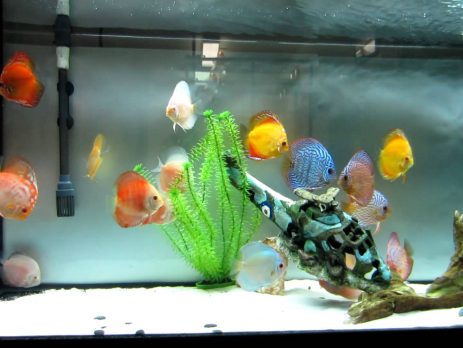
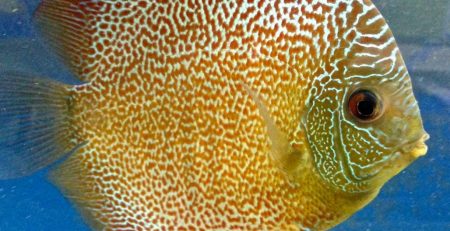


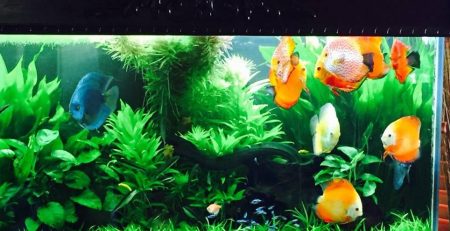

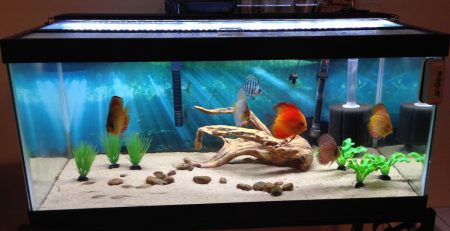

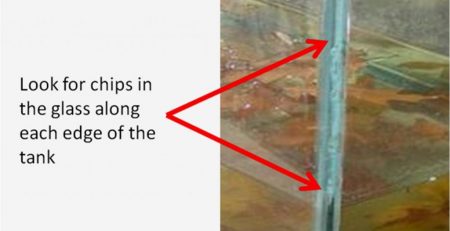
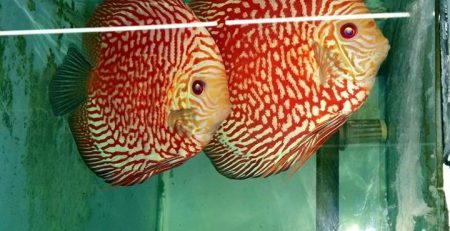
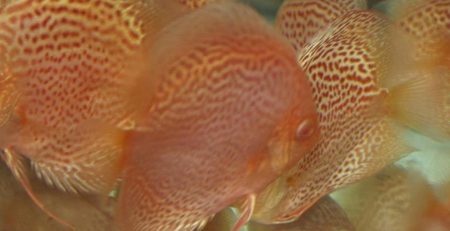
Leave a Reply
You must be logged in to post a comment.